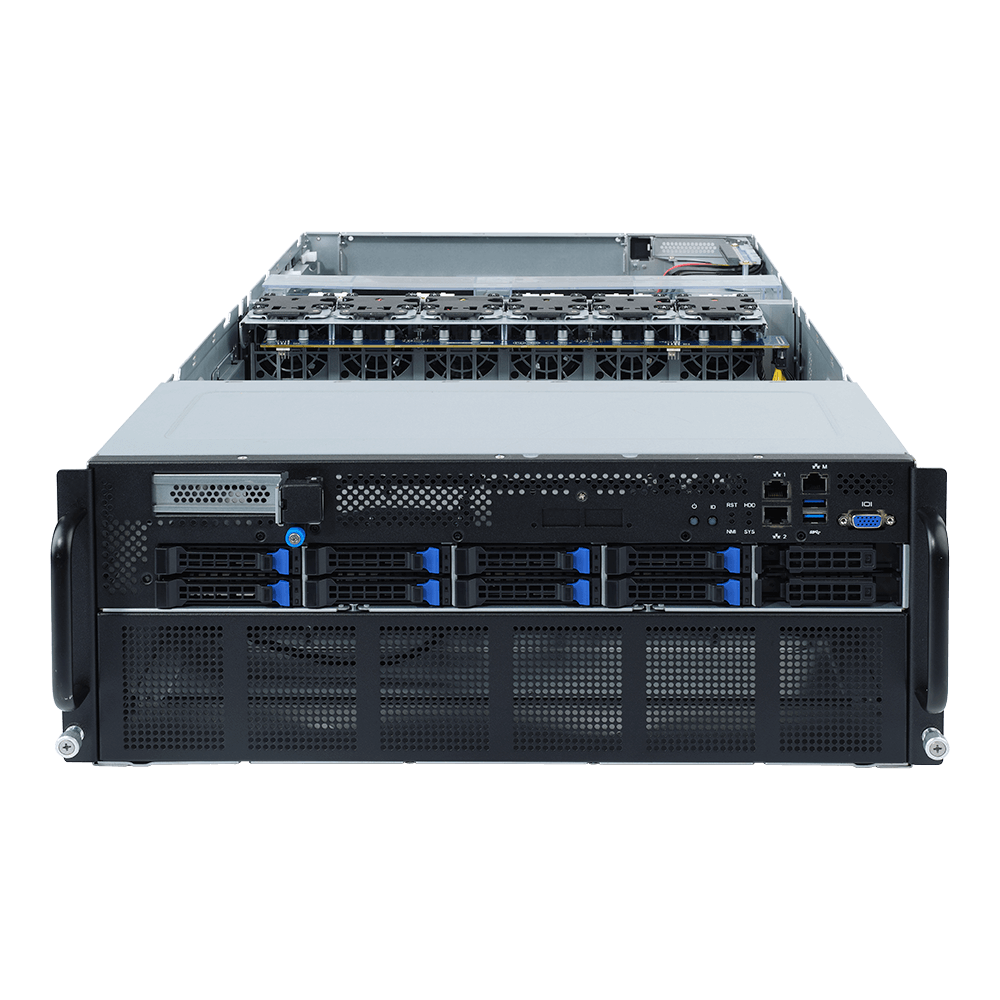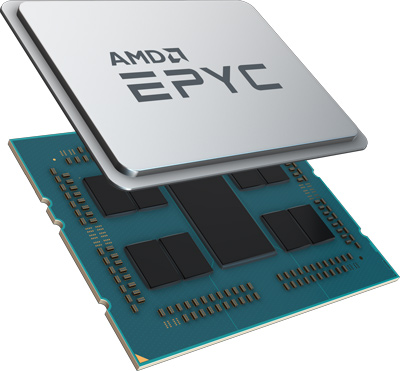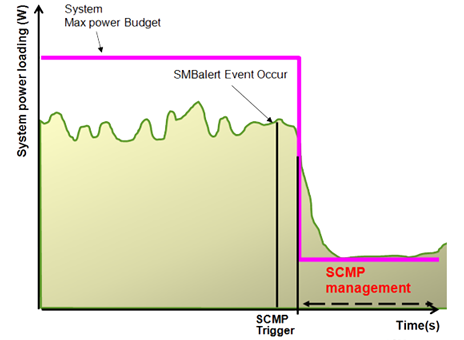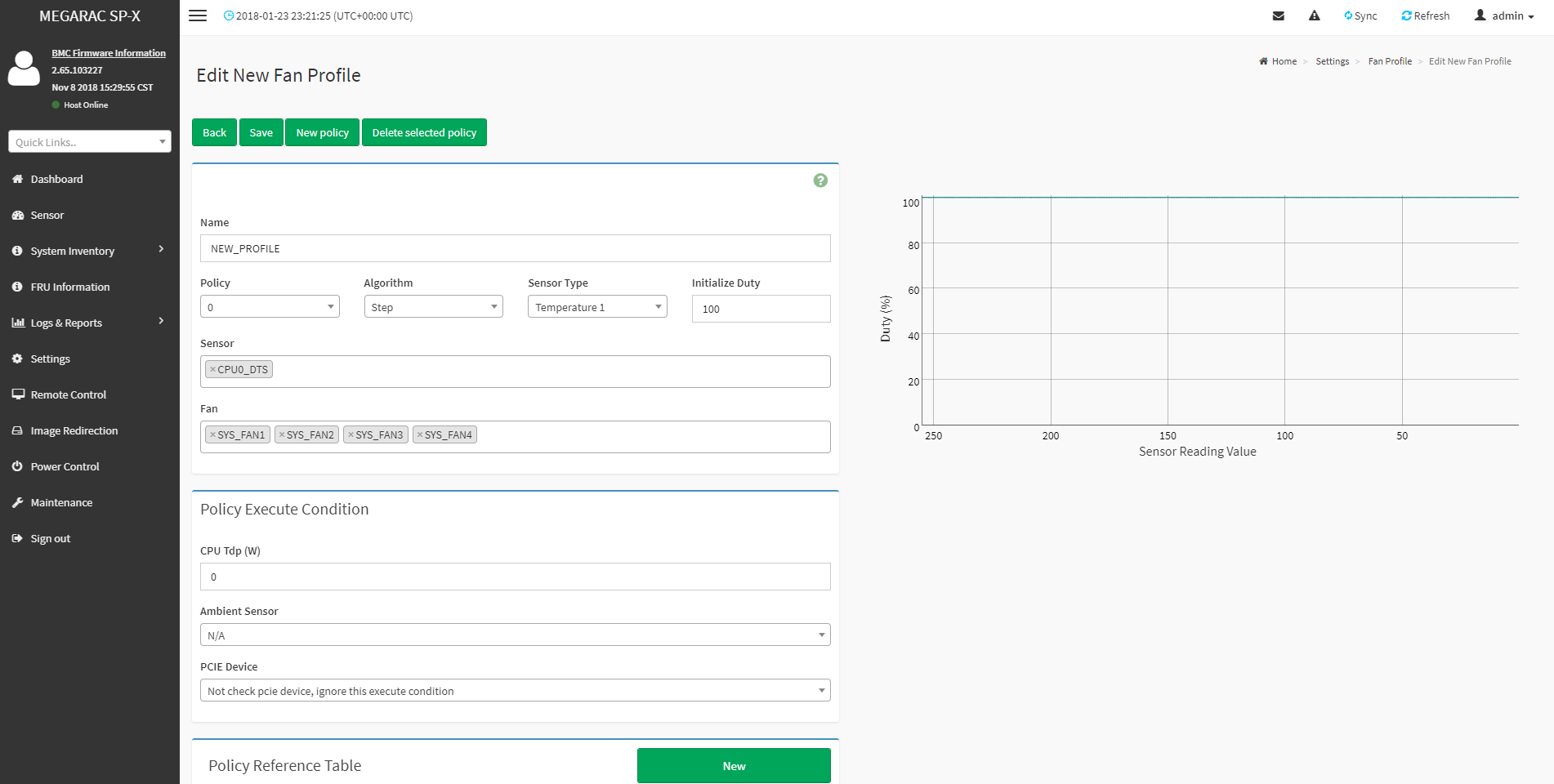





Product Features
AMD EPYC? 7002 Series Processor (Rome)
The next generation of AMD EPYC has arrived, providing incredible compute, IO and bandwidth capability – designed to meet the huge demand for more compute in big data analytics, HPC and cloud computing.
Built on 7nm advanced process technology, allowing for denser compute capabilities with lower power consumption
Up to 64 core per CPU, built using Zen 2 high performance cores and AMD’s innovative chiplet architecture
Supporting PCIe Gen 4.0 with a bandwidth of up to 64GB/s, twice of PCIe Gen 3.0
Embedded security protection to help defend your CPU, applications, and data

G482-Z52 Product Overview



GIGABYTE Management Console
GIGABYTE server utilizes the AMI MegaRAC SP-X solution for BMC server management, has a browser-based graphical user interface, and is feature-rich and easy to use.
RESTful API support includes the latest DMTF standard of Redfish. Allows integration with 3rd party applications for server management
Including HTML5 based iKVM remote management client, no need to purchase other additional licenses
Detailed FRU information from SMBIOS
10 to 30 seconds pre-event automatic recording function
SAS / RAID controller monitoring function
GIGABYTE Server Management (GSM)


GIGABYTE Server Management (GSM) is GIGABYTE’s proprietary multiple server remote management software platform, available as a free download from each GIGABYTE server product page. GSM is compatible with either IPMI or Redfish (RESTful API) connection interfaces, and comprises the following sub-programs:
GSM Server, a software program with an easy to use browser-based GUI to enable global remote monitoring and management of multiple
GIGABYTE servers via each server node’s BMC.
GSM CLI, a command-line interface program to enable global remote monitoring and management of multiple GIGABYTE servers via each server node’s BMC.
GSM Agent*, a software program installed locally on each GIGABYTE server node that retrieves additional node information (CPU/Mem/HDD/PCI/…) from the OS and passes it to the BMC. This information can then be utilized by GSM Server or GSM CLI.
*GSM Agent is currently compatible with Avocent MergePoint IPMI 2.0 BMC firmware, but not yet compatible with Megarac SP-X BMC firmware.GSM Mobile, a remote server management mobile APP, available for both Android and iOS.
GSM Plugin, a plugin that allows the user to manage and monitor GIGABYTE server nodes within VMware’s vCenter.
Intuitive & Informative User Interface
Starting from the GSM Server dashboard, the user can clearly understand the status of each node in the IT environment, including:
Node connection status (system is online/offline)
Node hardware sensor status (to detect hardware anomalies). Sensors measure voltage, fan speed and temperature
Node usage rate status (allowing you to timely allocate more resources when they are needed), including:
Power consumption
Disk/RAID usage information
Memory usage rate
CPU usage rate
Network card / PCI information
G482-Z52 System Block Diagram

High Density HPC
Supports 8 x PCIe Gen 4.0 Computing Cards
The G482-Z52 is one of the world’s first PCIe Gen 4.0 GPU server systems to be released to the market, featuring support for up to eight dual-width PCIe Gen 4.0 GPU cards (with each GPU connected directly to the processor via PCIe root). It is ideal to integrate an “AMD on AMD” solution using 2nd Gen EPYC processors together with the Radeon Instinct MI50, the world’s first 7nm, PCIe Gen 4.0 data center GPU, or with other Gen 3.0 or Gen 4.0 GPU cards for applications such as deep learning, cloud gaming or video streaming.

AMD Radeon Instinct? MI50 Support
This GIGABYTE server features support for AMD’s Radeon Instinct? MI50 compute card, designed to deliver high levels of performance for deep learning, high performance computing (HPC), cloud computing, and rendering systems.
Based on “Vega 7nm” Technology with 60 supercharged Compute Units (3840 Stream Processors)
Up to 53 TOPS INT8 Performance for Inference Workloads
Up to 26.5 TFLOPS FP16 and 13.3 TFLOPS FP32 Performance for Training Workloads
Up to 6.6 TFLOPS Double Precision for HPC
16 GB or 32 GB Ultra-fast HBM2 ECC Memory with up to 1 TB/s Memory Bandwidth
The World’s First PCIe? Gen 4 x16 Capable GPU
AMD Infinity Fabric? Link – up to 184 GB/s peer-to-peer GPU communication speeds
ROCm Open Ecosystem

NVIDIA? V100 Tensor Core GPU Support
GIGABYTE’s AMD EPYC server systems and motherboards are fully compatible and qualified to use with NVIDIA? V100 Tensor Core GPUs, an advanced data center GPU built to accelerate AI, HPC, and graphics. Powered by NVIDIA Volta? architecture and with 640 Tensor Cores, the NVIDIA V100 has broken the 100 teraflops (TFLOPS) barrier of deep learning performance — enabling data scientists, researchers, and engineers to tackle challenges that were once impossible.

PCIe Gen 4.0 Ready
AMD EPYC Rome is ready to support PCIe Gen 4.0 with a bandwidth of 64GB/s, twice that of PCIe Gen 3.0. This doubles the bandwidth available from the CPU to peripheral devices such as graphics cards, storage devices and high speed network cards. GIGABYTE’s AMD EPYC 7002 Series server platforms are ready to be used with a new generation of PCIe Gen 4.0 devices such as AMD’s Radeon MI50 GPGPU.
* The PCIe 4.0 standard supports a 16 GT/s bit rate, (roughly 2GB/s per single lane) as opposed to 8GT/s bit rate for PCIe 3.0 (1GB/s).

Higher Memory Speed
AMD EPYC’s Rome 7002 Series processors feature faster 8 channel DDR4 memory lanes, supporting RDIMM or LRDIMM memory modules with a speed of up to 3200MHz (1 DIMM per channel)

More M.2 Storage
GIGABYTE’s AMD EPYC 7002 Series server platforms feature more M.2 drive capacity for ultra-fast NVMe storage – both onboard M.2 slots and extra capacity via optional riser cards.

Max TDP Support
GIGABYTE’s AMD EPYC server platforms come ready to support the full list of AMD EPYC 7002 Series processors: up to 225W (standard TDP) / 280W (cTDP)

Data Security
TPM 2.0 Module
GIGABYTE’s AMD EPYC Server is designed to support Trusted Platform Modules (TPM - discrete cryptographic on-board processors).

Carefully Selected Components
GIGABYTE’s passive components are carefully selected to guarantee a stable operating environment and allow the processors and the memory to deliver their maximum performance. GIGABYTE’s server motherboards are built with long lasting components for a high degree of reliability and durability.

Design Features for Easy Maintenance
GIGABYTE’s AMD EPYC 7002 Series server platforms contain many tool less design features for easy installation, maintenance and removal – never worry about forgetting your toolbox or losing a screw again!
Tool-less Rail Kits
Rail kits attach to the side of the server chassis via clipping mechanism.

Tool-less 2.5” & 3.5” Drive Bays
Clipping mechanism secures the drive in place. Install or replace a new drive in seconds.

Efficient, Reliable Power Supply
GIGABYTE’s AMD EPYC 7002 Series server are designed to guarantee high conversion efficiency regardless of load. Redundant 80 Plus ‘Titanium’ or ‘Platinum’ PSUs, combined with GIGABYTE’s precision engineering, translates to super efficient power usage which maximizes the system’s power : performance ratio and reduces OPEX for the user.

Intelligent Power Management Features
SCMP (Smart Crises Management / Protection)
SCMP is a GIGABYTE patented feature that will automatically force the system’s CPU to enter ULFM (ultra-low frequency mode for minimum power consumption) when the BMC is alerted to a PSU fault or error (such as power loss, power surge, overheating or a fan problem). This feature will prevent shutdown in systems with less than 1 + 1 PSU redundancy when one PSU is lost.

Dynamic Fan Speed Control
GIGABYTE servers are enabled with dynamic fan speed adjustment. Individual fan speed will be automatically adjusted according to the system’s current temperature (according to CPU, DIMM, M.2, HDD, GPU temperature sensors), to achieve the best cooling and power efficiency. When the BMC detects a temperature change, fan speed will be automatically adjusted accordingly. Fan speed profiles may also be manually created and edited* when necessary according to the user’s custom requirements.
* Enabled on selected models & performed through BMC console management GUI

Environmental Compliance
GIGABYTE maintains its commitment to green products, and adheres to the latest RoHS regulations (in effect July 2017).

VMware Technology Alliance Partner
Being a member of VMware's Technology Alliance Partner (TAP) program enables GIGABYTE to rapidly develop and certify joint solutions or go-to-market products that leverage VMware virtualization and cloud solutions, enabling our customers to modernize their data centers and implement IT infrastructure and application services with speed, agility, and cost optimization.
Enquire with your GIGABYTE sales representative for more information about combining or integrating this server product with VMware solutions.

Technical Specifications
